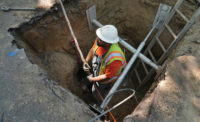Although ENR’s indexes measure the costs of non-residential buildings, the housing market recovery has had a major impact on index movement. The ENR 20-city average price for 2x4 lumber is up 10.4% this year, following last year’s 12.2% hike. Structural steel and cement prices in the cost indexes posted slight increases, 3.3% and 1.1%, respectively. Labor costs also experienced a modest gain. As a result, the ENR Building Cost Index is up 2.6% for the year, after rising 3.9% last year, while the Construction Cost Index is 2.7% higher, following a 2.7% annual increase a year ago.
ENR began reporting materials prices and wages systematically in 1909, but it did not establish the CCI until 1921. The index was designed as a general-purpose tool to chart basic cost trends. Today, it remains as a weighted aggregate index of the prices of a constant quantity of structural steel, portland cement, lumber and common labor. This package of goods was valued at $100, using 1913 prices.
The original use of common labor in the CCI was intended to reflect wage-rate activity for all construction workers. In the 1930s, however, wage and fringe benefit rates climbed much faster in percentage terms for common laborers than for workers in the skilled trades. In response to this trend, ENR introduced, in 1938, its Building Cost Index (BCI) to weigh the impact of skilled-labor wage changes on overall costs.
The BCI labor component is the average union wage rate, plus fringe benefits, for carpenters, bricklayers and ironworkers. The materials component is the same as the CCI’s. The BCI also represents a hypothetical package of these construction items, valued at $100 in 1913.
Both indexes are designed to indicate the basic underlying trends of construction costs in the U.S. Therefore, components are based on construction materials that are influenced less by local conditions. ENR chose steel, cement and lumber because they have a stable relationship to the U.S. economy and play a predominant role in construction.
As a practical matter, ENR selected these materials because reliable price quotations are available for all three, ensuring both indexes can be computed on a timely basis. While there may be some weaknesses in any index based on a limited number of components, ENR thinks a larger number of elements would increase the time lag between verifying prices and releasing the index. Also, an index with fewer components is more sensitive to price changes than one that includes many.
On the downside, however, the use of only a few cost components makes indexes for individual cities more vulnerable to source changes. These aberrations tend to average out for the 20-city indexes, which ENR recommends for general use.
Since the indexes are computed with real prices, the proportion a given component has in an index will vary with its relative escalation rate. In the late 1970s, labor’s share of the index dropped because materials prices were in the grip of hyperinflation. For example, in 1979, lumber prices increased 16%, cement prices increased 13% and steel prices jumped 11%, but labor rose only 8%. These developments resulted in materials gaining a larger percentage of the index.
In the original CCI, the components were weighted at 38% for labor, 38% for steel, 17% for lumber and 7% for portland cement. The shifting tide of inflation changed the weight of the CCI components, making labor 81%, steel 13%, lumber 5% and cement 1%. This shift was less dramatic for the BCI, which is now 66% for labor, 23% for steel, 9% for lumber and 2% for cement.
Neither index is adjusted for productivity, contractor overhead or profits. However, the indexes can get a fix on these factors. As a rule, when productivity is low, the selling price will be relatively higher than the ENR index. Generally, when competition is sharp, the selling price of finished construction will fall below ENR’s indexes.




